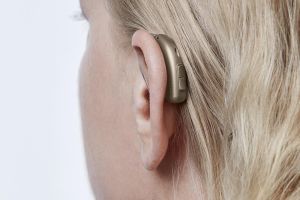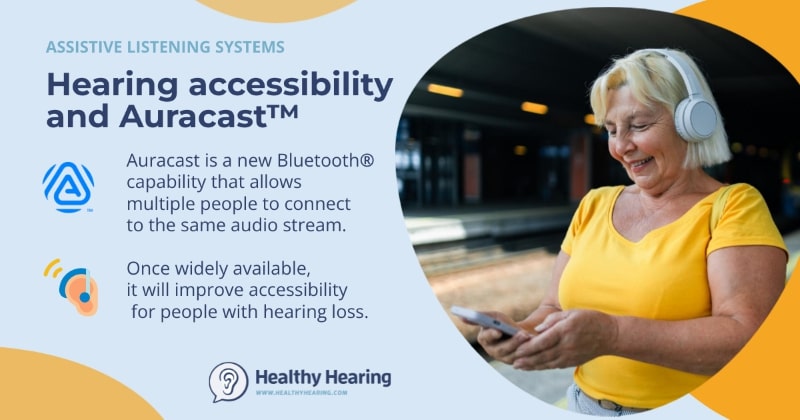|
www.HealthyHearing.com |
Auracast™ and hearing aids: What to knowA hearing loss advocate weighs in on the benefits—and limitations—of this broadcast audio technology
Contributed by Linda Childers Key points:
It’s Friday night and you’re meeting up with friends at your favorite café to watch a baseball game on TV. The place is packed, silverware clinks against plates, and a hum of chatter fills the air. With one quick tap on your phone, the game’s play-by-play streams straight into your hearing aids. Suddenly, the sounds you want to hear are crystal clear and the background noise fades away. That’s the kind of experience Auracast broadcast audio hopes to bring to life—once it’s widely available and works for most hearing aids, that is.
What is Auracast?Auracast is broadcast audio technology from Bluetooth that lets you share audio from one device to many others at the same time, like music or announcements. It’s especially useful for hearing aids because it lets them directly pick up shared audio streams in public places, like an airport gate announcement. Instead of needing special equipment or neck loops, hearing aids with Auracast can connect wirelessly through Bluetooth LE Audio, giving clearer sound and easier access. 
Juliëtte Sterkens, AuD, with the Hearing Loss Association of America (HLAA), says the new technology is exciting, but right now only a handful of hearing devices support it. “Auracast has two main uses,” Sterkens explains. “The first is broadcast audio. Think of a TV in an airport or gym that can stream to anyone nearby with compatible earbuds, headphones, or hearing aids.” The second use, Sterkens says, is to replace older systems like FM systems. With Auracast-enabled hearing aids or earbuds, you’ll be able to connect directly to sound systems in classrooms, theaters, etc., making it easier to catch every word of a lecture or performance. Until now, hearing loops have been the best option for delivering sound directly to hearing aids in places like lecture halls and theaters. When will Auracast be available in hearing aids?While some hearing aids, like Oticon Intent™, can now access Auracast broadcasts, wider availability is still a ways off. It could take two to ten years before most hearing aid companies release Auracast-ready models, according to Sterkens. And like with any new tech, early versions may have glitches. “One big question is what happens if multiple Auracast streams are running in the same place—will there be interference?” she says. The official international standards for Auracast used for assistive listening won’t come out until late 2027, and Sterkens explains that, like hearing loop standards, these rules will outline how the system should work—everything from audio processing and signage to what counts as an assistive listening system, and how much delay (latency) is acceptable. What to consider if you’re buying hearing aids with AuracastReal-world use of Auracast has already started in some places. If you’re thinking about buying Auracast-enabled hearing aids now, Sterkens says it’s important to know about the current limitations and to bring the right questions to your audiologist. Things to keep in mind include: Limited availability: Right now, most airports, theaters, and lecture halls still rely on hearing loops, FM and infrared systems or offer no assistive listening systems at all. Auracast probably won’t be widely available until after standards are finalized in 2027. You can ask your audiologist if they know of places in your community already using Auracast. A consumer-searchable database of Auracast broadcast audio locations may be developed in the future. Google Maps, which already lists hearing loop locations is expected to permit users to find Auracast locations as well. Limited device compatibility: Not every phone, TV, or pair of earbuds is ready for Auracast audio. If your tech doesn’t support it, you won’t get the full benefit yet. Also, ask your audiologist if your current phone, TV, or tablet will support Auracast broadcast audio or if you will need to buy new devices. Software issues: Software updates are uneven. For example, Android 16 added Auracast hearing support, but earlier versions don’t have it. At this early stage, Sterkens says to expect some connection issues and cross-brand hiccups. Public accessibility features vs. private use: Streaming music or TV to multiple devices will likely roll out faster than public accessibility features. For now, hearing aids that support Auracast may feel like regular Bluetooth devices, great for home use, but not widely available in public spaces just yet. Cost: Early Auracast-enabled hearing aids are mostly high-end models, meaning you may pay more for limited benefits at first. Sterkens recommends asking your audiologist if it makes sense to buy Auracast now or wait until the technology is more common and affordable. If you do buy now, find out whether your hearing aids can be updated later with software updates or if you need to replace the entire device. Ease of use vs. reality: Although Auracast is promoted as being easy to use, Sterkens points out there may be a learning curve. In the early years, most Auracast hearing aids will depend on a smartphone or tablet to find and connect to broadcasts. The phone acts like a remote control, letting users see a list of Auracast streams like “Gate A23 TV” at an airport that you can tap to join. In the future, it is essential for Auracast hearing aids to connect directly, without needing a phone and there are concerns that the hearing aid manufacturers are not making easy-to-use functions. For now, though, Sterkens says those with vision problems, dexterity issues or who are unable to use a smartphone with ease, may find setup and switching between broadcasts a bit challenging. 
are curious about hearing aids that support Auracast broadcast audio. Level of hearing loss: Sterkens recommends that people with more than mild hearing loss choose hearing aids that have both Auracast and telecoils. Why? Because while new devices like TVs, laptops, and phones, will likely support Auracast in the future, hearing loops with telecoils are already available in public spaces. Having a telecoil connects to neckloops in FM, and infrared systems. Having both options means you can connect easily at home with Auracast and still benefit from clear sound in theaters, churches, and other venues that currently use hearing loops, FM and infrared. All three systems are required under the ADA and multiple countries around the world. Which hearing aids have Auracast?The Center for Hearing Access keeps a list of hearing aids that are currently Auracast-enabled. Before you buy, check the list and talk to your audiologist about what will work best with your phone, TV, and the places you visit. “If you plan to keep your hearing aids for four to eight years or more, I suggest waiting before you buy a new pair,” Sterkens says. “With new technology, it often helps to skip one or two generations so you avoid early bugs and get better features. It is not necessary to have Auracast built into your hearing aids if your current devices include telecoils, you will still be able to benefit from Auracast if the theater offers Auracast neckloop receivers." Telecoils are still a good ideaIf you decide to buy today, choose hearing aids that support both Auracast and telecoils, Sterkens says. "You’ll be ready for future Auracast broadcasts at home and in public, while still having reliable access to hearing loops, FM, and infrared systems that are common today.”
Related Help Pages:
Hearing aids Technology Bluetooth Assistive listening devices and systems FM/DM systems
|
Featured clinics near me
Earzlink Hearing Care - Reynoldsburg
7668 Slate Ridge Blvd
Reynoldsburg, OH 43068

Find a clinic
We have more hearing clinic reviews than any other site!


